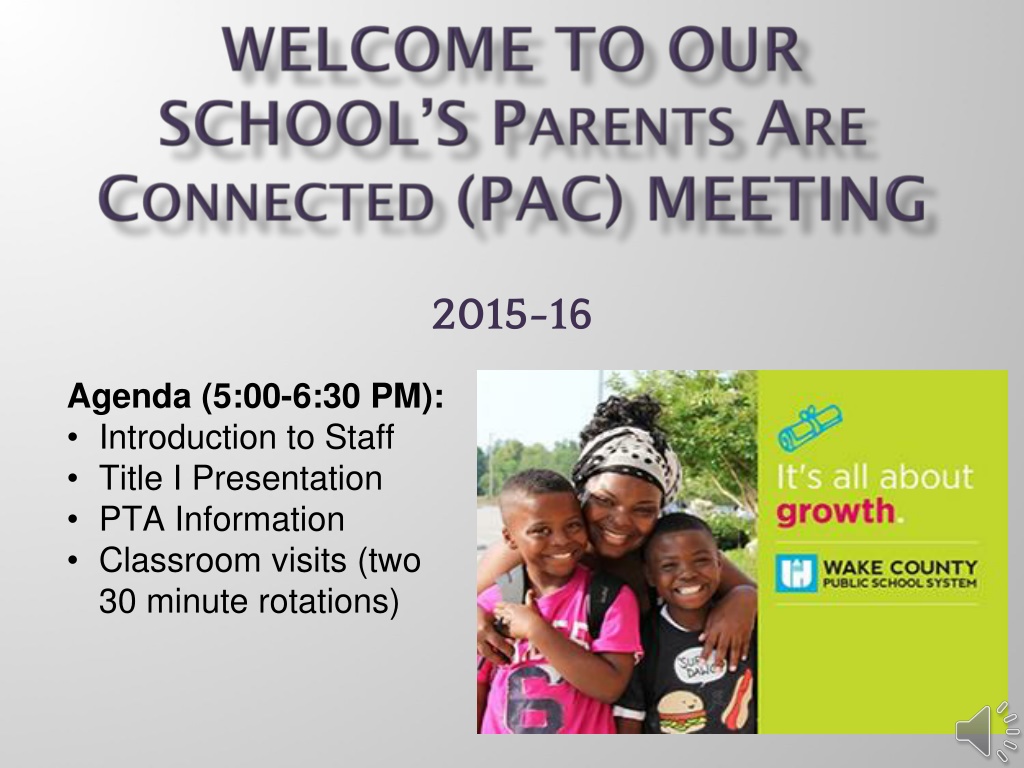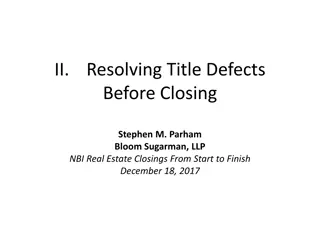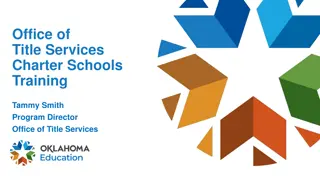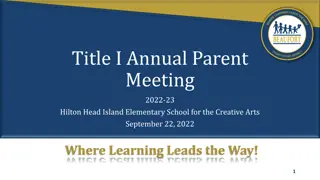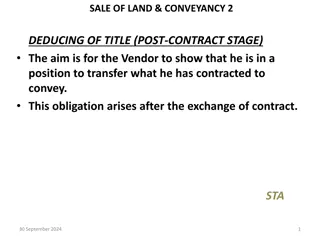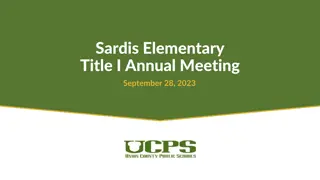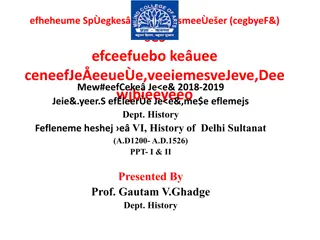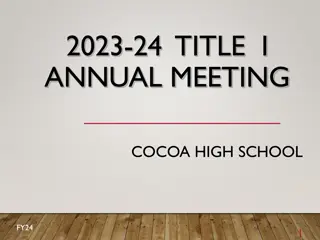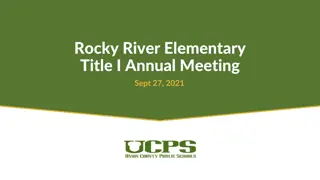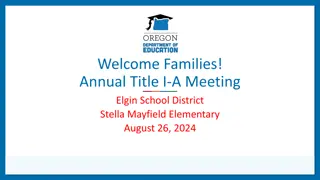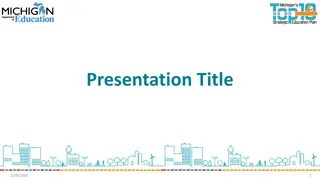Introduction to Title I Program
Federal funding under NCLB to support academically struggling students. Learn about Title I, its purpose, funding usage, parent involvement, and the ESEA history. Discover how NCLB promotes accountability and equal access to education.
Download Presentation

Please find below an Image/Link to download the presentation.
The content on the website is provided AS IS for your information and personal use only. It may not be sold, licensed, or shared on other websites without obtaining consent from the author.If you encounter any issues during the download, it is possible that the publisher has removed the file from their server.
You are allowed to download the files provided on this website for personal or commercial use, subject to the condition that they are used lawfully. All files are the property of their respective owners.
The content on the website is provided AS IS for your information and personal use only. It may not be sold, licensed, or shared on other websites without obtaining consent from the author.
E N D
Presentation Transcript
2015-16 Agenda (5:00-6:30 PM): Introduction to Staff Title I Presentation PTA Information Classroom visits (two 30 minute rotations)
What is Title I? It is federal funding that is attached to NCLB/ESEA legislation It is intended to help students who are falling behind academically and/or who are at risk of not meeting end- of-grade standards Its funds are allocated based on the number of students eligible for free/reduced lunch in a school. What can funds be used for? To hire teachers, purchase materials and supplies, parental involvement activities, professional development, pre-kindergarten programs, etc.
Parent Rights/Involvement To get actively involved in your child s school To get information about School and District Programs To request information about Staff Credentials To review the Parent Involvement Policy (WCPSS Board policy 2541, including Regulations & Procedures) To participate in Parent Involvement Programs (at your child s school and the district level) To know how your child s school is doing. The Dept. of Public Instruction (DPI) publishes the NC Report Card for each public school in the state www.ncreportcards.org.
The Elementary and Secondary Act of 1965 provided our country s first broad assurance of equal access to public education for all children. ESEA has been reauthorized (revised and renewed by Congress) seven times, most recently at the end of 2001 by the No Child Left Behind Act (NCLB). ESEA reauthorization usually occurs every 5 years, however NCLB has governed elementary and secondary education for about a decade.
NCLB maintained the original overarching goal of ESEA. It challenged states to set high academic standards and to increase school and school system accountability. It also exposed achievement gaps between some minority students, Economically Disadvantaged students, Students With Disabilities, and English Language Learners, and their higher achieving peers.
Title I and the Elementary & Secondary Education Act ESEA Why did the US Department of Education allow states to apply for waivers from No Child Left Behind? We want to get out of the way and give states and districts flexibility to develop locally tailored solutions to their educational challenges, while protecting children and holding schools accountable for better preparing young people for college and careers. Secretary Arne Duncan, September 23, 2011
Over the past few years, states and districts have initiated groundbreaking reforms and innovations to accelerate the achievement of their students. To capitalize on these types of opportunities, North Carolina requested waivers from many of the NCLB requirements. These were approved in May 2012. These requests outlined a rigorous and comprehensive plan for improving public schooling through improving educational outcomes for all students, closing achievement gaps and increasing equity, and improving the quality of instruction. Three critical areas of these waivers are: College and career readiness School, school system, and student Accountability Effective instruction and leadership
What are the benefits of ESEA flexibility? Schools are no longer judged by an all or nothing standard. With AYP goals, they did not make AYP if they missed just one target goal. The Annual Measurable Objectives (AMOs) set for each sub-group more fairly judge schools based on student and school progress The goal of closing achievement gaps for each sub-group by half by the year 2017 is necessary and attainable The expectations set forth in the waivers for greater student engagement in their learning using critical thinking skills aligns with the high expectations set forth in Common Core and Essential Standards Principals have greater flexibility to tailor solutions to the unique educational challenges of their students, and schools will receive recognition for progress and for performance.
Since there is no AYP, how will school success be measured? Annual Measurable Objectives or AMO s Sub-groups must make progress each year toward closing the achievement gaps by half by 2017. Target goals for each subgroup are set by the state. The proficiency of students who are members of these sub-groups will be measured against these targets. The target AMOs are the same for all elementary schools in North Carolina.
. However, the sub-groups that each school will be held accountable for are .. (A school must have 30 or more 3rd-5th grade students in a sub-group to have its data reported) American Indian Academically/Intellectually Gifted Asian Black Economically disadvantaged Hispanic Limited English Proficient Multi-racial Students With Disabilities White
ExcellentPublic Schools Act: Read to Achieve Implementation began in 2013-2014, and it has an impact on 3rdgrade students. Students who do not pass their Reading EOGs may attend a reading camp. If they are proficient in Reading at the end of the reading camp, they will be promoted to 4thgrade. If they are not proficient in Reading at the end of the reading camp, they will be retained in 3rdgrade but will go to a grade 3-4 Transition classroom. In this 3-4 Transition class, they must participate in a 90-minute reading class or an accelerated Reading class intended to accelerate their Reading skills. Around mid-year, students will be assessed. If they are proficient in Reading, the retained label will be removed and they will be 4thgraders. If not, the retained in 3rdgrade label will remain.
How will you know if your child meets the grade level standards? Stay in close communication with your child s teacher(s). Be sure to read all communications sent home by the school. Talk with your child.
What can parents do to help? Ensure that your child does her/his homework and turns it in. Read with your child(ren) Talk through everyday math applications with them grocery story, cooking/baking, making purchases, building/repairing something, etc. Be sure you understand how your child is performing in reading and mathematics. Talk with your child s teacher and principal. Communicate your school s successes in your community. Look for ways to support your school.
